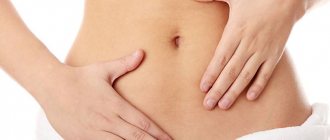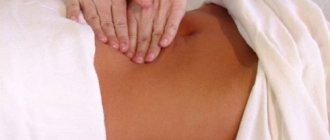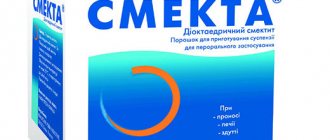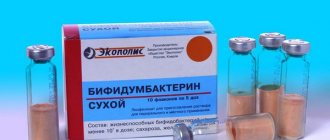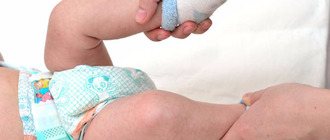Causes of colic in a baby
The appearance of colic in a child is accompanied by uncomfortable digestion.
The reasons for this can be varied:
- Termination of the functioning of maternal hormones in the child’s body, which are transmitted to him during development in the womb and passage through the birth canal. Confirmation of this reason is the formation of acne on the baby’s skin, which is also a consequence of hormonal changes.
- An unbalanced mother's diet can affect the baby's digestive system. The composition of breast milk depends on the diet followed by a nursing mother. Changing the balance of proteins, carbohydrates and fats in milk can negatively affect gas formation in the baby’s intestines.
- The child is allergic to foods included in the mother’s diet. In this case, colic is accompanied by other unpleasant symptoms: rash, diarrhea and irregular bowel movements.
- A newborn baby is just learning the correct breathing process. While breathing or crying, he often swallows air. In this case, air enters the intestines, which leads to pressure on its walls. Accumulated gases cause discomfort to the baby, causing colic.
- Incorrect latching technique on the breast or bottle also allows air to enter the digestive tract. When air gets in with food, pain in the abdomen intensifies, and its duration can increase up to 3 hours.
- The baby is unable to burp trapped air after feeding. In this case, it remains in the intestines, where it compresses its walls.
- The child spends most of his time in an upright position. When he lies down for a long time, digestion slows down. This prevents the timely release of gases.
- The child gets more food than he needs. Overfeeding leads to depletion of digestive enzymes, which is why some of the food remains undigested. Such food debris accumulates in the intestines, causing fermentation and bloating.
Characteristics of massage and general rules
Massage belongs to the category of therapeutic and preventive. It is used to alleviate the condition of infants who already suffer from the accumulation of gases in the intestines, as well as to prevent colic in babies who have not yet complained of increased gas production.
The massage can be done at home; there is nothing complicated about it. His techniques are simple and understandable; any pediatrician you ask will be happy to show them. But even without the presence of a doctor, the massage technique is not complicated, and we will discuss it in detail below.
Massage helps strengthen the weak anterior abdominal wall, improves peristalsis, promotes the passage of intestinal gases, and helps with constipation in infants, which also occurs almost everywhere at an early age. The release of gases as a result of massaging movements relieves spasms of the intestinal wall, pain decreases and disappears, gases escape outward, the child is able to sleep and eat peacefully.
Symptoms
Colic is manifested by pain in the abdomen, but it should be distinguished from diseases of the gastrointestinal tract.
The following symptoms indicate the presence of colic:
- Time of onset of pain. With colic, a child may suddenly cry out when feeding, which indicates sharp pain in the abdomen.
- High-pitched screaming and shuddering in the evening also indicates colic, if at other times of the day the child is healthy and calm.
- The child grunts and strains during feeding or a short time after it.
- The child’s desire to pull his legs higher towards his stomach, bending them at the knees.
- Changes in bowel movements or difficulty having regular bowel movements.
- Frequent attacks of flatulence.
- The child develops restlessness and restlessness for no apparent reason.
- Cry.
- The baby's belly is inflated, and when you touch it with your hand, you can feel the movement of gases inside it.
- By listening, you can distinguish the sounds of iridescent liquid.
- A sudden onset of symptoms, and then an equally sudden end.
Execution technique
The mother’s hands must be warm when the manipulations begin. You can also apply a warm (not hot) diaper to your baby’s tummy for a few minutes. Once you have warmed your own hands and your baby’s belly, you can begin.
- Soften your hands with cream or oil (if you don’t have a massage oil, you can use any herbal one). Apply a little product to your tummy and distribute evenly.
- Massage the abdomen with light circular movements with an open palm, without touching the umbilical wound. Avoid pressing with your palm: pressure can cause an attack of pain in the baby. The exercise is performed 10-12 times.
- Using your index and middle fingers, with slightly more noticeable pressure, begin to “draw” spirals on your belly - from the navel to the ribs, increasing each subsequent turn.
- The next exercise will resemble the movement of the blades of a water mill. Place both hands on your tummy, palms down. One hand massages the transverse muscles, and the other - the obliques.
- With one hand, grab the baby's legs in the shin area, and with the other, start moving from the lower left corner of the abdomen up to the diaphragm, parallel to it and down. Thus, you draw the letter “P”. It is important to start on the left side, from the descending part of the intestine. This will help “push” the accumulated bubbles of intestinal gases to the natural physiological outlet to the outside - to the anus.
- Place the baby on its side. Gently move your open palm along the back, moving to the side muscles. In this case, with your second hand you need to press your legs bent at the knees towards your stomach. After 10-15 such exercises, turn the child over to the other side and repeat again.
- Return the child to the position on his back, grab the legs at the feet, do several synchronized and alternate movements of the legs to the tummy (“Bicycle”, “Squats”).
- Carefully, gently and delicately stroke the tummy again, the movements should be soothing.
- Bring your legs toward your belly and help your baby have a bowel movement if he or she is constipated by lubricating the anus with petroleum jelly and lightly irritating it with a thermometer. If there is no constipation, it is not necessary to stimulate bowel movements. Usually, after finishing the massage, if it is carried out correctly, the child will poop in the shortest possible time.
Why do you need massage for colic?
Massage of the tummy during colic in a newborn is necessary to facilitate the elimination of gases, as well as to calm the nervous system. The baby has not yet developed a full-fledged central nervous system. Because of this, he reacts to the slightest unpleasant stimuli.
The feeling of pressure or bloating in the abdomen causes the child to become hysterical. Massage allows you to:
- Warm the organs of the digestive system. This improves the functioning of the gallbladder and liver, allowing gases to be eliminated faster.
- Stimulate the child's appetite. When colic occurs, the baby often begins to refuse food, unconsciously avoiding unpleasant consequences. Massage will awaken the desire to eat.
- The calming effect on the nervous system will make the baby calmer during feeding. He will stop making unnecessary movements with his arms and legs, and will also suck the bottle or breast more energetically, preventing air from entering.
- Slowly stroking the tummy reduces the likelihood of cramps. This will prevent pain from colic.
About colic
Before you begin massage and other methods of dealing with infant colic, you should make sure that the baby is crying and capricious precisely because of them, and not for another reason. Recognizing colic is quite simple: when a child has an intestinal spasm, he tightens his legs, turns red, and bursts into tears. The crying is sharp and demanding, and the pain with colic is really quite severe. Most often, babies suffering from colic begin to cry while eating or immediately after feeding.
The causes of colic, as already mentioned, are not obvious. Pediatricians tend to see the reason in the imperfect production of enzymes and their insufficient levels in the newborn, in the physiological immaturity of the intestine and the period of formation of its normal functioning.
More often than others, premature babies, babies born with low weight and malnutrition, as well as large children whose weight at birth exceeded 4 kilograms are susceptible to colic. A special risk factor is overfeeding. If a child is overfed, then he suffers from colic many times more often. Errors in breastfeeding or bottle feeding, when the baby swallows air with food, also increase the likelihood of developing infant colic.
The peak of suffering occurs at the age of 0-3 months. Usually after this period the child calms down and the colic goes away. But for parents of a newborn, three months seems like an incredibly long period of time that still needs to be overcome somehow.
Pediatricians offer many ways to eliminate them: synthetic drugs against colic based on simethicone - drops, applying heat (a heating pad or a diaper pre-ironed with an iron). A special tummy massage also occupies a special place among effective methods.
Preparing for a massage
Before you begin the massage, you need to perform a number of preparatory steps:
- The room where the massage will take place should be pre-ventilated.
- The temperature in the room should be comfortable for the child - 22 - 24 degrees.
- The massage should begin 10 minutes before. before feeding or 1 hour after digestion of food.
- Jewelry must be removed from your hands. They can cause discomfort to the child, which is why he will begin to resist the massage.
- Nails should be cut short so as not to injure the umbilical wound and the baby's delicate skin.
- You should stop using massage oils. They cause discomfort and increased pressure on the stomach with hands due to slipping.
- Before the massage, you should place a heating pad or a bag of warm salt on the child’s stomach for 2 to 3 minutes. You can use a warm sheet heated with an iron. Heat will enhance the effect of the massage.
- Before giving a massage to your baby, you need to wash your hands and dry them thoroughly. They should not be wet or cold.
- Warming up movements will help warm your hands. To do this, you need to alternately rub one hand against the other.
Massage in stages
Tummy massage for colic in a newborn is carried out in stages:
- Stroking the abdomen from top to bottom with light touches of the hand.
- Stroking in a circular motion clockwise.
Illustration of tummy massage for colic in a newborn - Light soothing strokes from the ribs to the lower abdomen.
- Movements from above to below with alternate changes of hands placed horizontally on the stomach.
- Sliding movements with the edge of the palm clockwise, without contact with the right hypochondrium.
- Movement of the palm from the back to the tummy in the direction of the muscles.
- Stroking the belly with both palms facing each other.
How often should a tummy massage be done for colic in a newborn?
If the newborn enjoys gymnastics and massage, then each procedure can be done two approaches daily. If the effect is not noticeable, then perhaps mommy is doing something wrong. Pediatricians advise doing gymnastics in the morning: before meals or an hour after feeding, and massage in the evening, even before bed. If the child is hyperactive, then exercises can disrupt sleep patterns, so procedures should be carried out long before quiet time.
Getting used to the outside world, newborns often behave irritably and feel discomfort. Proper nutrition, massage and gymnastic exercises will minimize increased gas formation and the appearance of cramps in the stomach. Even if you are just lying on the bed with your baby, stroke his tummy with light movements in a clockwise direction. This will not only create a warming effect, but will also have a calming effect.
How to finish a massage correctly
To complete the massage, you must follow the recommendations:
- The child's legs should be bent at the knees and then applied to the stomach to release gases.
- Within 2 – 3 minutes. The child must be left lying on his back.
- To relax your legs, you need to stroke them from bottom to top.
- These steps should be repeated 2 – 3 times.
Preparatory activities
Before you start performing a massage, you need to make sure that the child is capricious and crying really because of colic. The symptoms of this condition are similar to those of other diseases. It is advisable to show the baby to a pediatrician. The doctor will immediately determine the cause of the baby’s poor health.
Signs of colic include the following:
- the child draws up his legs;
- redness of the skin;
- strong crying.
Most often, attacks occur during or immediately after feeding. If the cause of crying is colic, then you can start massage.
List of preparatory activities:
- make sure that the room has an optimal microclimate for the child. The air temperature should be at +20-21 degrees, humidity – within 50-70%;
- find a place for the session. A special changing table is ideal. The surface must be hard, smooth and even;
- Place accessories and items necessary for the procedure on the edge of the table. You will need a disposable diaper, oilcloth, baby cream or oil, thermometer, wet wipes, Vaseline oil.
Hands need to be treated with antiseptic
The mother needs to remove all bracelets and rings and cut her nails short. This is necessary to minimize the likelihood of injury to the baby. Before performing a massage, hands should be washed in warm water and soap, and then treated with an antiseptic solution (alcohol or Miramistin).
The baby should be unswaddled and allowed to lie naked for a few minutes. This is necessary so that the child gets used to room temperature. You can apply a warm, ironed diaper to your stomach for a couple of minutes.
Acupressure for colic
A tummy massage for colic in a newborn can be done using the acupressure technique:
- The peculiarity of this massage is to gently press certain points on the child’s body. Thanks to the baby’s thin skin, this technique is highly effective.
- When exposed to a point, the activity of receptors and muscles increases, which helps the body remove gases.
- Pressure on the points occurs with stroking and vibrating movements.
- The massage begins with working on a point located 3 fingers below the navel.
- The points around the navel should be massaged clockwise one by one.
- The procedure ends with working out the points located in the direction of the abdominal muscles from the navel to the back.
Rules for performing massage
Massage against colic in a newborn must be done correctly. It is worth organizing this process not only during the period of bloating, but also as a form of prevention. To do this, there is a list of key points that need to be taken into account:
- You cannot begin massage actions without preparation.
- The room should have a comfortable temperature, and the mother’s hands should be warm and moisturized with baby cream or massage oil.
- First you need to warm the baby's skin. To do this, just walk around with him in your arms for a few minutes.
- Sudden movements or strong pressure are excluded. You need to move your hands smoothly in the form of light strokes.
- The baby must be naked so that the skin is saturated with oxygen; the diaper does not need to be removed.
- Carry out this process on a changing table or bed, but the surface should be smooth and not too soft.
- Before using massage oil, make sure that your baby is not allergic to it. Do not overdo it with pressure on the skin, because oily compounds create slipping and result in more pressure than usual.
- It is forbidden to carry out massage actions if the umbilical cord has not yet healed.
- All movements must be done clockwise.
- One procedure should last 5-7 minutes, no more.
Important! Any departure from the rules can negatively affect the well-being of the baby. If you are not sure that you can carry out the procedure correctly, it is better to hire a massage therapist.
Contraindications
Massage is contraindicated in the following cases:
- Constipation.
- Bloody discharge in the stool.
- Fever or chills.
- Vulnerability of the skin.
- Unhealed umbilical wound.
- Asymmetrical abdominal structure.
- Umbilical hernia.
Gymnastics for colic and constipation in babies
Gymnastics allows a child not only to improve digestion, but also to develop the capabilities of the body. A special feature of gymnastic techniques is the possibility of close contact with the mother and broadening one’s horizons, as well as developing the nervous system. Gymnastics promotes the active growth of the child, and it can be done every morning even at the age of up to 1 month.
However, in the following cases, gymnastics should be abandoned:
- Fever.
- Rickets.
- Pustular skin diseases.
- Hernias.
Gymnastics should be performed when the baby is in a good mood. Exercises are performed on a hard surface, such as a changing table. The exercises are repeated 2–3 times, and their total duration should not exceed 10 minutes.
| Exercise No. 1 | Exercise No. 2 | Exercise No. 3 | Exercise No. 4 | Exercise No. 5 |
| The baby should be placed on his stomach. You need to clasp the child's feet with your hands, pressing on the soles. His response will be a jerk forward. | The child must be placed on his back. His left leg should be bent at the knee and placed behind the right. Then put your legs to your stomach and back. Repeat similarly with the right leg. | The child should be placed on his back. You need to hold him by the hands, pulling him up. In this case, the child’s legs should also be directed upward. | The child should be held vertically above the table by the chest. When lowered onto the table, he will make pushing movements with his legs. | The child must be placed on his back. With your right hand you need to take his right hand, and then turn the baby from his back to his stomach. |
Preparation
Before starting the massage, make sure that the correct microclimate is created in the room, optimal for the newborn. The air temperature should be no higher than 21 degrees Celsius with an air humidity of 50-70%.
The child needs to prepare a suitable place for manipulation. A flat and hard surface is optimal, on which, when lying on the back, the baby’s vertebrae will not “sag”, but will be in the correct position. A changing table is ideal for a good place. If you don't have one, you can use a regular table.
All items and accessories that you will need during the massage should be placed on the edge of the table. The mother should not turn away from the baby even for a minute: the height of the changing table, and even the dining table, is quite enough for a fall, aggravated by severe traumatic consequences.
For the procedure you will need:
- oilcloth;
- several wet wipes in case the baby pees himself to quickly clean his skin of urine;
- disposable diaper;
- clean thermometer.
- baby oil or cream;
- a little Vaseline oil.
Exercises for colic for newborns on a fitball
Fitball exercises serve as a prevention of colic and a way to eliminate pain. A special feature of this technique is its positive effect on muscles. They are strengthened, and muscle hypertonicity is eliminated. The child receives a charge of positive emotions and energy.
This technique is contraindicated in certain conditions:
- acute respiratory infections and acute respiratory viral infections.
- Inflammations on the skin.
- Hernias.
- Weight deficiency.
- Heart disease.
The duration of the gymnastics is about 10 minutes. You can do the exercises every day if the baby is not capricious and does not refuse to do them. During exercises, the child should not be pulled or used force.
| Exercise No. 1 | Exercise No. 2 | Exercise No. 3 |
| The child must be placed with his stomach on the ball, holding him by the arms and legs. The legs need to be brought together and lowered all the way down. | The child should be placed on the ball with his back, holding him by the chest. The baby needs to be rolled up and down. | The child should be placed on the ball with his stomach, holding his legs with his hand. With your free hand you need to make springy movements along the baby's back. |
Recommendations of Dr. Komarovsky
Massaging the tummy for colic is not the only way to combat pain.
A well-known pediatrician recommends the following tips for newborns:
- Accustom your baby to a pacifier.
- Follow the norms and feeding regimen.
- Observe temperature standards in the room where the baby is.
- Do not abuse medications for gas formation in the intestines.
- A nursing mother should exclude caffeine and dairy products from her diet.
- The problem can be solved by replacing the formula with artificial feeding.
- In severe cases, a gas tube should be used.
There is no universal remedy for colic in a newborn. However, massaging the tummy when unpleasant symptoms appear helps prevent pain and cramps.
Author: Alena Lash
Article design: Vladimir the Great
What to do after a massage
To consolidate the effect of the session, it is necessary to carry out calming movements from left to right. The baby is turned over on his stomach, gently massaging his back. Massage the tummy of a newborn should not exceed 20 minutes . After this, the child is allowed to rest, the diaper or diaper is removed, and he is left to take air baths.
The baby needs to massage the tummy area every day, and not just when faced with a problem. Simple techniques will have a beneficial effect on the development of the baby’s internal organs; colic, bloating and stool retention will stop faster.
Read other related articles:
- Dill water from gaziki - how to prepare it yourself and how much to give to kids;
- A gas outlet tube is an emergency way to remove excess air from a baby’s intestines.
